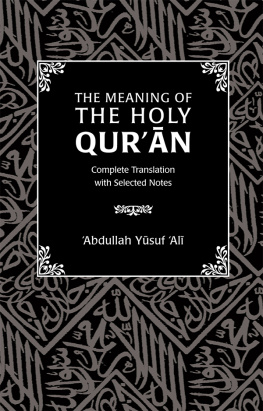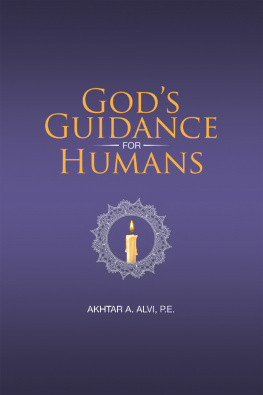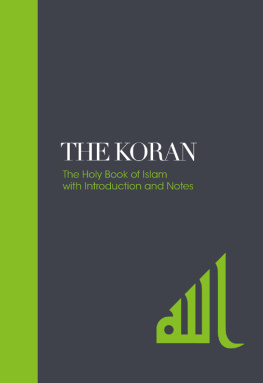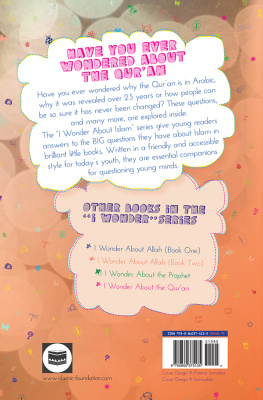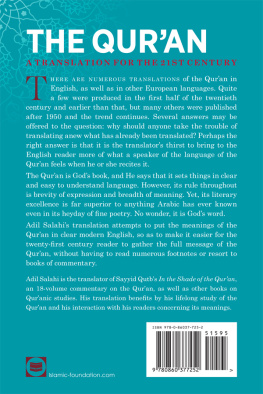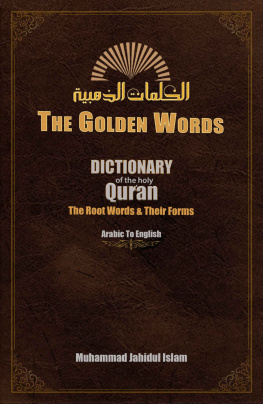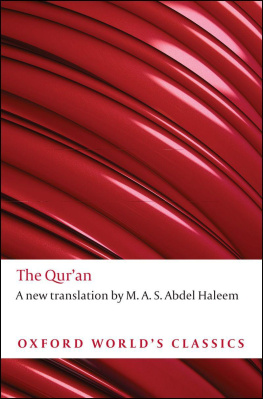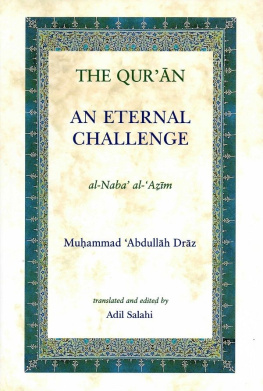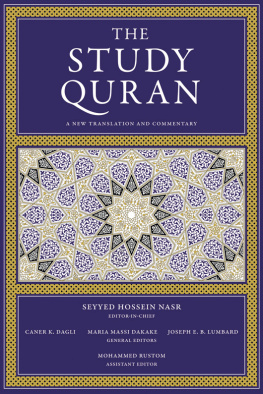
The Meaning of The Holy Qurn
THE MEANING OF
THE HOLY QURN
Complete Translation with Selected Notes
Abdullh Ysuf Al
THE ISLAMIC FOUNDATION
The Islamic Foundation Published 2003/1424 A.H. Reprinted 2005/1426 A.H.; 2009/1430 A.H.
Published by
The Islamic Foundation
Markfield Conference Centre
Ratby Lane, Markfield
Leicestershire, LE67 9SY, United Kingdom
Tel: 01530 244944/5, Fax: 01530 244946
E-mail:
Website: www.islamic-foundation.org.uk
Quran House, P.O. Box 30611, Nairobi, Kenya
P.M.B. 3193, Kano, Nigeria
Distributed by
Kube Publishing Ltd.
Tel: +44 (0)1530 249230, Fax: +44 (0)1530 249656
E-mail:
All rights reserved. No part of this publication may be reproduced, stored in a retrieval system, or transmitted in any form or by any means, electronic, mechanical, photocopying, recording or otherwise, without the prior permission of the copyright owner.
British Library Cataloguing-in-Publication Data
The Meaning of the Holy Qurn: Complete Translation with Selected Notes
1. Koran Commentaries
I. Ali, Abdullah Yusuf, 1872-1952. II. Islamic Foundation (Great Britain) 297.122521
ISBN 978086037-392-6
Cover Design by Nasir Cadir
Publishers Note
IT IS our great pleasure and privilege to bring out a compact and thoroughly revised edition of Abdullh Ysuf Als translation of the Qurn in modern English. The Islamic Foundation was the first publishing house in the West to issue this translation in 1975. Over the years, however, there had been a growing need for a handy English translation of the Qurn for average readers. An elaborate tafsr work with copious notes or a translation without any explanatory notes could not meet the needs of the anglophone-reading public. Accordingly, we have brought out the present edition which, apart from containing complete translation of the Qurnic text, retains essential notes of Abdullh Ysuf Als exhaustive commentary on the Qurn, which would enable the readers to gain a better understanding of the meaning and message of the Qurn.
Since its first appearance in 1934, Ysuf Als translation has held the pride of place amid English translations by Muslim scholars. Indicative of its wide popularity are its, at least, forty editions issued from Saudi Arabia, USA, India, Pakistan, Malaysia, UK and other parts of the world. For years its copies have been distributed free of charge by the Saudi Arabian embassies throughout the world. The merits of this work are manya highly readable paraphrase of the Qurnic text into chaste, idiomatic English; helpful explanatory notes displaying the authors wide range of scholarship and providing necessary background information about historical allusions made in the Qurn. Notwithstanding its phenomenal popularity, serious reservations were expressed by Muslim scholars about Ysuf Als views on al-Ghayb. Accordingly the Editorial Committee, set up by the Presidency of Islamic Researches Ifta, Call and Guidance, King Fahd Holy Qurn Printing Complex, Madinah, Saudi Arabia, thoroughly revised this work. It now stands free of the shortcomings which had marred the original edition. This revised edition came out in 1990. We have drawn upon it and corrected some of the mistakes which had crept into this edition as well. Every effort has been made to present this rendering in modern English, avoiding the archaic, Biblical expressions employed in the earlier editions. As already indicated, a bare minimum of 472 explanatory notes out of a total of 6306 have been retained in the present edition. At times, these have been considerably abridged. The original number of the notes features in a square bracket at the end for those readers who may like to refer to the original note for a detailed study.
Prefaced to the present work is an excellent piece by Sayyid Abul Ala Mawdudi entitled as Understanding the QurnAn Introduction to the study of the Qurn. It is of immense help and guidance for the uninitiated readers of the Qurn. For it clearly instructs how one should approach the Qurn which is not a book in the conventional sense of the term: more importantly, it sheds ample light on various outstanding features of the Qurnits uniqueness, its guidance, its central theme, its Makkan and Madinan Srahs, its style and arrangement, its compilation, its universality and some valuable suggestions for its study. This Introduction would go a long way in preparing readers mentally for grasping the life-giving message of the Qurn. Another feature aiming at enhancing the value of this work for readers is the inclusion of a brief Introduction to each Srah, containing a synoptic account of the contents and other salient points which would contribute to appreciating better the guidance embodied in the Qurn. The extensive thematic Index should also be of much benefit for readers.
One of the reasons prompting us to bring out this handy edition of the Qurn translation was the increasing interest in Islam expressed by non-Muslims in the wake of 11 September events. We are confident this work would go a long way in familiarising them with the meaning and message of Islam. It would help dispel some misperceptions about things Islamic. May Allah Sub nah wa Tal accept our effort in this cause.
It is our pleasant duty to thank our friends and colleagues, without whose invaluable help and assistance this work could not be produced. Particular mention should be made of Haji Koya Kutty, Islamic Book Trust, Kuala Lumpur, Malaysia; Chowdhury Mueen-Uddin and Dilwar Hussain, Islamic Foundation, Leicester; E. R. Fox and A. R. Kidwai, Aligarh Muslim University, Aligarh, India.
May Allah accept our endeavour in the cause of presenting before mankind the eternal message of the Qurn, the final Divine guidance for all times and places (mn). We shall be obliged for your comments and suggestions, which would enable us to improve upon this work in the next edition.
Rab al-Awwal 1422H June 2002 | Dr. M. Manazir Ahsan Director General The Islamic Foundation |
Transliteration
Guide to Pronouncing Arabic Words
For some Arabic vowels and sounds there is no English equivalent. In order to help readers overcome this problem some special marks have been put on certain words in this book.
For example, , and stand for the vowel sounds aa (as in path), ee (as in feet) and oo (as in pool) respectively.
Similarly, the signs () and () have been used for the Arabic letters hamzah (as in Wu) and ayn (as in Kabah).
Arabic Alphabet and its English Equivalent

Contents
Chapter
Sayyid Abul Ala Mawdudi
This piece has been written with two objectives. First, to acquaint the reader with certain matters which he should grasp at the very outset, so as to achieve a more than superficial understanding of the Holy Book. Second, to clarify those disturbing questions that commonly arise in the mind of the reader during the study of the Qurn.
I
We are accustomed to reading books which present information, ideas and arguments systematically and coherently. So when we embark on the study of the Qurn, we expect that this book too will revolve around a definite subject, that the subject matter of the book will be clearly defined at the beginning and will then be neatly divided into sections and chapters, after which discussion will proceed in a logical sequence. We likewise expect a separate and systematic arrangement of instruction and guidance for each of the various aspects of human life.

